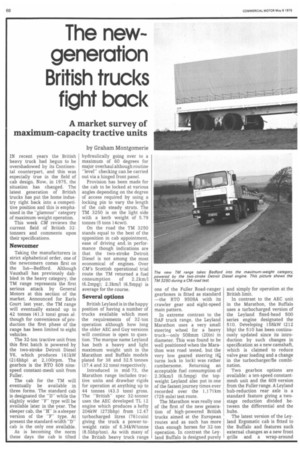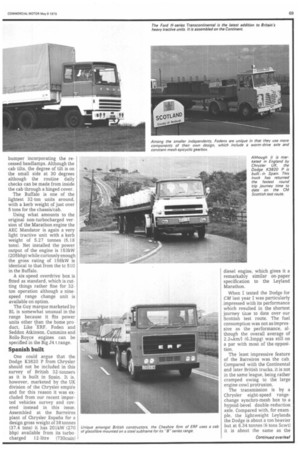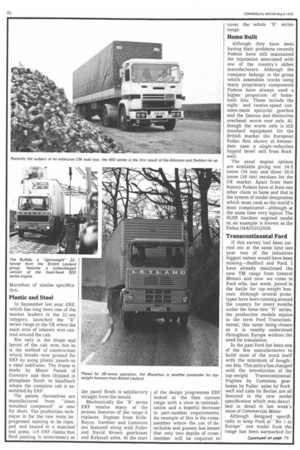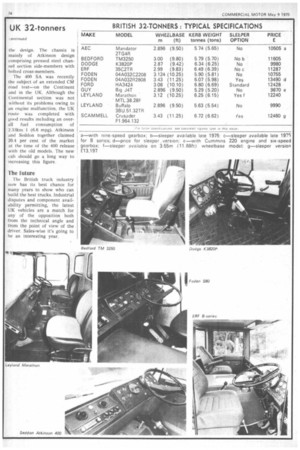The new generation British trucks fight back
Page 58

Page 59

Page 60

Page 64

If you've noticed an error in this article please click here to report it so we can fix it.
A market survey of maximum-capacity tractive units
by Graham Montgomerie
IN recent years the British • heavy truck had begun to be overshadowed by its Continental counterpart, and this was especially true in the field of cab design. Now, in 1975, the situation has changed. The latest generation of British trucks has put the home industry right back into a competitive position and this is emphasised in the "glamour" category of maximum-weight operation.
This week CM reviews the current field of British 32tonners and comments upon their specifications.
Newcomer
Taking the manufacturers in strict alphabetical order, one of the newcomers comes first on the list—Bedford. Although Vauxhall has previously dabbled in the heavy category, the TM range represents the first serious attack by General Motors at this section of the market. Announced for Earls Court last year, the TM range will eventually extend up to 42 tonnes (41.3 tons) gross although for convenience of production the first phase of the range has been limited to eight vehicles.
The 32-ton tractive unit from this first batch is powered by the two-stroke Detroit Diesel V6, which produces 161kW (216bhp) at 2,100rpm. The gearbox is the RTO 609 ninespeed constant-mesh unit from Fuller.
The cab for the TM will eventually be available in three forms. The standard cab is designated the "D" while the slightly wider "F" type will be available later in the year. The sleeper cab, the "H" is a sleeper version of the "F" type. At present the standard-width "D" cab is the only one available.
As is becoming the norm these days the cab is tilted hydraulically going over to a maximum of 60 degrees for major overhaul although routine "level" checking can be carried out via a hinged front panel.
Provision has been made for the cab to be locked at various angles depending on the degree of access required by using a locking pin to vary the length of the cab steady struts. The TM 3250 is on the light side with a kerb weight of 5.79 tonnes (5 tons 14cwt).
On the road the TM 3250 stands equal to the best of the opposition in cab appointment, ease of driving and, in performance though indications are that the two-stroke Detroit Diesel is not among the most economical of engines. Over CM's Scottish operational trial route the TM returned a fuel consumption of 2.2km/I (6.2mpg); 2.3km/1 (6.5mpg) is average for the course.
Several options
British Leyland is in the happy position of having a number of trucks available which meet the requirements of 32-ton operation although how long the older AEC and Guy versions will continue is open to question. The marque name Leyland has both a heavy and light maximum weight unit in the Marathon and Buffalo models plated for 38 and 32.5 tonnes (37.4 and 32 tons) respectively.
Introduced in mid-73, the Marathon range includes tractive units and drawbar rigids for operation at anything up to 44 tonnes (43.3 tons) gross. The "British" spec 32-tonner uses the AEC developed TL 12 engine which produces a hefty 204kW (273bhp) from 12.47 turbocharged litres 761cuin) giving the truck a power-toweight ratio of 6.34kW/tonne (8.5bhp/ton). As with many of the British heavy truck range one of the Fuller Road-ranger gearboxes is fitted as standard —the RTO 9509A with its crawler gear and eight-speed main pattern.
In extreme contrast to the DAF truck range, the Leyland Marathon uses a very small steering wheel for a heavy truck—only 508mm (20in) in diameter. This was found to be well positioned when the Marathon was road tested, but the very low geared steering (61 turns lock to lock) was rather cumbersome. Returning an acceptable fuel consumption of 2.30km/1 (6.5mpg) the topweight Leyland also put in one of the fastest journey times ever recorded over the 1,171km (728-mile) test route.
The Marathon was really one of the first of the new generation of high-powered British trucks aimed at the European routes and as such has more than enough horses for 32-ton operation. In contrast the Leyland Buffalo is designed purely and simply for operation at the British limit.
In contrast to the AEC unit in the Marathon, the Buffalo uses a turbocharged version of the Leyland fixed-head 500 series engine designated the 510. DeVeloping 158kW (212 bhp) the 510 has been continuously updated since its introduction by such changes in specification as a new camshaft, which is claimed to reduce valve gear loading and a change in the turbocharger/fie combination.
Two gearbox options are available: a ten-speed constantmesh unit and the 609 version from the Fuller range. A Leyland hub-reduction rear axle is a standard feature giving a twostage reduction divided between the differential and the hubs.
The latest version of the Leyland Ergomatic cab is fitted to the Buffalo and features such external changes as a new front grille and a wrap-around bumper incorporating the recessed headlamps. Although the cab tilts, the degree of tilt is on the small side at 30 degrees although the routine daily checks can be made from inside the cab through a hinged cover.
The Buffalo is one of the lightest 32-ton units around, with a kerb weight of just over 5 tons for the chassiSicab.
Using what amounts to the original non-turbocharged version of the Marathon engine the AEC Mandator is again a very light tractive unit with a kerb weight of 5.27 tonnes (5.18 tons). Net installed the power output of the engine is 153kW (205bhp) while curiously enough the gross rating of 158kW is identical to that from the tc 510 in the Buffalo.
A six-speed overdrive box is fitted as standard, which is cutting things rather fine for 32ton operation although a ninespeed range change unit is available on option.
The Guy marque marketed by BL is somewhat unusual in the range because it fits power units other than the home product. Like ERF, Foden and Seddon Atkinson, Cummins and Rolls-Royce engines can be specified in the Big 34 t range.
Spanish built
One could argue that the Dodge K3820 P from Chrysler should not be included in this survey of British 32-tonners as it is built in Spain. It is, however, marketed by the UK division of the Chrysler empiie and for this reason it was excluded from our recent imported vehicles survey and covered instead in this issue. Assembled at the Barreiros plant of Chrysler Espana for a design gross weight of 38 tonnes (37.4 tons) it has 201kW (270 bhp) available from its turbocharged 12-litre (730cuin) diesel engine, which gives it a remarkably similar on-paper specification to the Leyland Marathon.
When I tested the Dodge for CM last year I was particularly impressed with its performance which resulted in the shortest journey time to date over our Scottish test route. The fuel consumption was not as impressive as the performance, although the overall average of 2.2,..km/I (6.3mpg) was still on a par with most of the opposition.
The least impressive feature of the Barreiros was the cab. Compared with the Continental and later British trucks, it is not in the same league, being rather cramped owing to the large engine cowl protrusion.
The transmission is by a Chrysler eight-speed rangechange s.ynehro-mesh box to a hypoid-bevel double-reduction axle. Compared with, for example, the lightweight Leylands the Dodge is about a ton heavier but at 6.34 tonnes (6 tons 5cwt) it is about the same as the Marathon of similar specification.
Plastic and Steel
In September last year. ERF, which has long been one of the market leaders in the 32-ton category, launched the "B" series range in the UK when the main area of interest was centred around the cab.
Not only is the shape and layout of the cab new, but 'so is the method of construction which breaks new ground for ERF by using plastic panels on a steel subframe. The frame is made by Motor Panels of Coventry and then shipped in phosphate finish to Sandbach where the complete cab is assembled by ERF.
The panels themselves are manufactured from "sheet moulded compound" or smc for short. The production technique is for the raw resin impregnated matting to be clamped and heated in a matched tool press and ERF claims that final sanding is unnecessary as the panel finish is satisfactory straight from the mould.
Mechanically the "B" series ERF retains many of the proven features of the range it replaces. Engines from RollsRoyce, Gardner and Cummins are featured along with Fuller and David Brown gearboxes and Kirkstall axles. At the start of the design programme ERF looked at the then current range with a view to rationalisation and a hopeful decrease in part-number requirements. An example of this is the crossmember where the use of detachable end gussets has meant that only two depths of crossmember will be required to cover the whole "B" series range.
Home Built
Although they have been having their problems recently Fodens have still maintained the reputation associated with one of the country's oldest manufacturers. Although the company belongs to the group which assembles trucks using many proprietary components Fodens have always used a higher proportion of homebuilt bits. These include the eightand twelve-speed constant-mesh epicyclic gearbox and the famous and distinctive overhead worm rear axle. Although the worm axle is still standard equipment for the British market the European Foden first shown at Amsterdam uses a single-reduction hypoid bevel unit from Rockwell.
The usual engine options are available giving one 34.5 tonne (34 ton) and three 38.6 tonne (38 ton) versions for the UK market. Apart from their history Fodens have at least one other claim to fame and that is the system of model designation which must rank as the world's most complicated—although at the same time very logical. The 81JCB Gardner engined model as an example is known as the Foden 04A032G2508.
Transcontinental Ford
If this survey had been carried out at the same time last year two of the industries biggest names would have been missing—Bedford and Ford. I have already mentioned the new TM range from General Motors and now we come to Ford who, last week, joined in the battle for top-weight honours. Although several prototypes have been running around the country for many months under the loose title "H" series, the production models rejoice in the term Ford Transcontinental, this name being chosen as it is readily understood throughout Europe without the need for translation.
In the past Ford has been one of the few manufacturers to build most of the truck itself with the minimum of boughtout bits. This policy has changed with the introduction of the top-weight Transcontinental. Engines by Cummins, gearboxes by Fuller, axles by Rockwell and cabs by Berliet are all featured in the new model specification which was described in detail in last week's issue of Commercial Motor.
Although designed specifically to keep Ford at' "No 1 in Europe" one model from the range has been earmarked for the design. The chassis is mainly of Atkinson design comprising pressed steel channel section side-members with bolted cross-members.
The 400 SA was recently the subject of an extended CM road test—on the Continent and in the UK. Although the Continental section was not without its problems owing to an engine malfunction, the UK route was completed with good results including an overall fuel consumption of 2.33km. I (,6 mpg). Atkinson and Seddon together claimed 20.4 per cent of the market at the time ot the 400 release with the old models. The new cab should go a long way to increasing this figure.
The t ut ure
The British truck industry now has its best chance for niany years to show who can build the best trucks. Industrial disputes and component availability permitting, the latest UK vehicles are a match for any of the opposition both from the technical angle and from the point of view of the driver. Sales-wise it's going to be an interesting year.




























































































































































